Source: CCTV.com
08-15-2006 13:36
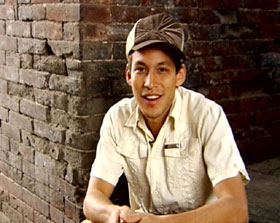 | |
Hi Everybody! Sorry about that, I must have dozed off, but dreams can kind of be like traveling, don't you think? Cause dreams can take you to some pretty cool places, and as much as this place looks like a dreamland, it’s actually real. We're in the city of Ping Yao Right now, this is a travelogue street special, I'm Gu Ming, and I'm gonna take you through the ancient streets of this ancient city
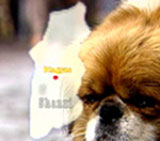 | |
The beautiful ancient city of Ping Yao is located at the center of Shanxi Province, and looks much the same today as it did during the Ming and Qing dynasties, when it was a bustling economic center of feudal China. "South Street” or "Nan Da Jie" was the main commercial street in Ping Yao. It runs north south down the center of the city, directly between the City government building and the Cheng Huan temple. Today South street is still the happening place in Ping Yao. It’s lined with museums, shops, and hostels, yet still retains its Ming - Qing dynasty style.
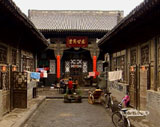 | |
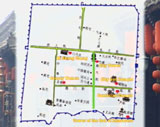 | |
Still surrounding the city are the ancient city walls that have protected the city for centuries. The previous wealth of Ping Yao is still apparent today. Much of the city is made up of traditional Chinese court yard dwellings, some of which are still homes for families who have lived there for hundreds of Years. Some of the larger courtyard mansions that were once homes to bankers or silk merchants have even been turned into guesthouses. These dwellings, called "Si He Yuan" attract People from all over the world, who come to Ping Yao to have a taste of what the Ming - Qing dynasty life style was like. Ping Yao is also famous for it's vaulted ceiling dwellings, which are characteristic of northwestern China. These "Yao Dong" dwellings are built of masonry and are known to stay cool in the summer and warm in the winter. The doors and windows are decorated with intricate woodcarvings that have survived for hundreds of years and give these houses a quaint yet artistic feel. This particular "Si He Yuan" is called "Wu Dai Tong Tang," which means 5 generations under one roof.
 | |
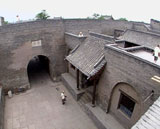 | |
Ping Yao's city wall, which has been standing since the Ming and Qing dynasties, has seen its share of revolutions and war. The masonry wall extends for six kilometers, and the dominance of Confucianism at the time it was built can be seen through the wall's 3,000 embrasures, which are said to represent the disciples of Confucius. The "Kui Xing Lou," on the south side of the wall, represents an excellence in academia and is just above the Confucius temple. The Confucian Temple not only holds a shrine for Confucius, but also was also a school and testing center used by the feudal Chinese government to appoint officials.
 | |
Such officials would come to work here, at the Ya Men, or the local branch of the Qing Dynasty government. There are three gates into the central courtyard; the center gate was reserved for guests of honor and high-level officials, while the east gate was the entrance for the status quo. The west entrance was kept for suspected criminals and candidates for death row.
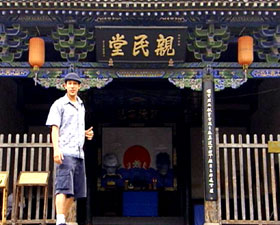 | |
Now I'm in the central courtyard of Ya Men, and behind me is an old Qing Dynasty courtroom.
-Some one has sounded the drum!
Judge-Bring in the one who sounded the drum!
 | |
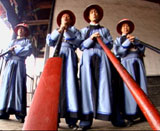 | |
Advisor-Bring in the one who sounded the drum!
Prosecution- Your Honor, I'm from Xi Guan Cun, Ping Yao, My name is Mao Lao Liu, age 76. I want to prosecute my unfillial son.
Defendant- My name is Mao Tian Liang, greetings your honor.
Judge- You got a lot of nerve Mao Tian Liang, Lying and talking your nonsense in this court of law, If I don't punish you, you'll never learn, Guards! 40 lashes!
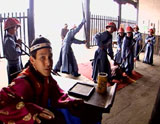 | |
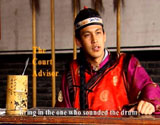 | |
Right now, I'm an advisor to a Qing Dynasty court. The guy sitting over there on the stage is the magistrate, he's the local judge of this town, the person to my left, which is the east, is the "accuser," the person to my right, which is the west, is the accused, right now he's getting punished for his crimes DA!
Hold on! Hold On! What is it old man!
Prosecution-He's my only son; With out him I have nothing left.
 | |
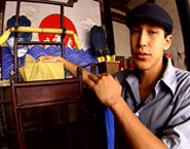 | |
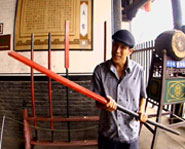 | |
Alright, now that my job as a court adviser is done, I can take off Hair, my hat and show you some of the interesting parts of this court room. This is the drum we saw in the beginning of the sketch. The drum is used to open the court. If you have a problem you want the magistrate to solve, you can bang on the drum and everyone will come out and listen to your case, but if your case is remedial and boring, and not important, they're gonna punish you, and this is what they usually punish you. This is a staff used for beating you, we saw that earlier, If you have a little money, you can pay them to hit you with the wide end, it doesn't hurt quite as much, but if you don't have any money, they'll hit you with this end, and this side hurts. And last but not least, we have the magistrate’s seal, and this seal was basically proof of his position, as well as his respect, it shows that he is a magistrate. So if I were to steal this thing, he wouldn't have a job anymore, So magistrates were very protective over their seals.
In the back of the Xian Ya, is a shrine for the "hu xian," a wily female Fox spirit, who the magistrate worshipped to protect their seals.
The fox spirit has always been my favorite character from Chinese folklore, but I never thought I'd actually find a shrine for her. If I ever run into the fox spirit, you might never see me again...
Directly opposite of the Government building across South Street on the east side of town is the Cheng Huan Miao, a daoist shrine where the local deity is worshipped. The Cheng Huan Miao is supposed to perform the same purpose as the Xian Ya, but in the afterlife, rather than the mortal world.
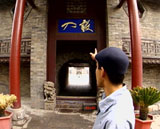 | |
I'm outside the inner gate to the local deity’s shrine, and if you look on top of the gate here, it's got a sign that says "Gan Ru" and it's basically asking you, "Is your conscience clean? Do you dare to enter to see the local deity if you've done something wrong in life? I think I'm cool, cause I'm a pretty cool guy, so I'm gonna go in and check it out.
 | |
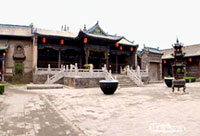 | |
The entrance to the main shrine was intentionally made low, so that visitors would have to bow respectfully upon entrance. The roofs of this temple are decorated with glazed tiles called "liu li wa." The bright blue tiles are glazed with "peacock blue," a color of glaze that artists today still cannot duplicate. Other that the large shrine dedicated to the local deity, there are also shrines for the three gods of fortune: the wu, wen and zheng cai shen. These deities specialize in bringing fortune to various aspects of life, and people can pray here for success in business, academia, or life in general. The temple's walls are also decorated with murals from the Qing dynasty, which have survived for hundreds of years. There is also a sculptural depiction of hell, with its graphic representations of punishments given in the afterlife for the sins committed while living.
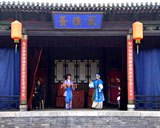 | |
Many temples in Ping Yao have opera stages built directly opposite of the deity's shrine, where operas performed as offerings on holidays. These stages were also watched by a human audience, who would come to the temple on holidays and watch opera along with the gods. These offerings are like the radio reception between the mortals and the gods. It lets the immortals know, that the humans are thinking about them. The oldest stage in Ping Yao is in front of the shine of the fortune gods in the Cheng Huan Miao. Even though the opera was considered an offering people crowded in to watch, and even balconies were built for the mortal audience.
 | |
Hey, Hey, does my voice sound like hot buttered heaven? It should because this stage was especially designed to accentuate performers voices. If you look at the ceiling, there's a dome that is meant to increase the presence of the singers voice. Under the foundation, there should be a group of large jars that are suppoed to increase the bass sound of the voice, and resulted in a better sound for he human audience, as well as the spiritual audience.
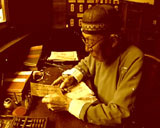 | |
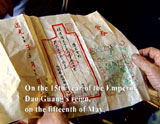 | |
The streets of Ping Yao have many tall walls that were once the status symbols of the wealthy. These particular Walls surround china's first Bank-like financial institution, The Ri Sheng Chang Piao Hao. This bank opened its doors in 1823 and specialized in the transfer of gold and silver currency and ended the history of armed escorts transporting gold on foot. At the time all money transfer slips were all hand written by bankers who hade to pas strict tests before they could work at the piao hao.
Gu ming: Is this a voucher from “Ri sheng Chang?”
Banker: This is a money transfer slip; it was written here at the Ping Yao branch of Ri Sheng Chang
Gu ming: It was written right here?
Banker: Whoever owned this voucher deposited money here, silver, at the time people used silver currency
Gu: how much silver was deposited?
B: hold on, let’s open it up and find out, the destination of this money transfer was to the Ri Sheng Chang, Beijing Branch. There was 66000 “liang” of silver
Gu: Really? That much money?
B: On the 15th year of the Emperor Dao Guang’s reign, on the fifteenth of May, this money was deposited for transfer to Beijing. The unfortunate part about this silver is that it was never withdrawn.
G: it was never withdrawn? Could I get it now?
B; Now? Sorry, this “Piao Hao” bank went out of business 70 years ago, in 1931.
The architecture of this building is beautifully preserved, and many of the old burglar alarm systems are still in place, yet the security here isn't nearly as high as it used to be, and tourists can now move freely through this old financial institution. The Ri Sheng Chang Piao Hao kept much of its currency in underground vaults, one of which has been found. Other Vaults are rumored to be under the courtyard, but they have yet to be unearthed.
 | |
Ping Yao is also known for its exquisite lacquer wear. The streets are dotted with shops that glisten with shining wood surfaces
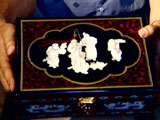 | |
Check out this piece of lacquer ware, it's nice and shiny, and it’s got this nice black color to it, but once it was a piece of wood. How do you get there? Lets take a look, First you have to have a piece of wood, you have to make sure its dry, cause if it's wet, it'll warp, and nobody wants a warped box. After you get a nice piece of wood, you put some gauze on it. The Gauze is what picks up the layer of smooth finish you see on the lacquer ware. After you put on the gauze, you use pig’s blood powder, to rub into the gauze and it gets this smooth finish here. Each layer takes about a day to dry, and you put about 5 layers and after each layer, you sand it down so its smooth. After its smooth, you put a layer of black lacquer on it. Once it's black, its ready to be painted.
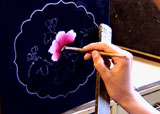 | |
The elegant illustrations are first rendered on the lacquer object. The standard black background strongly contrasts the brightly colored painting and is part of the traditional lacquer ware aesthetic.
So this beautiful piece of artwork is pretty much finished, but if you look carefully, the shiny finish on this box isn't the same as the finished piece over here, so now we're gonna look at how this glossy finish is done. The shine is obtained by repeatedly rubbing the lacquered surface with a small amount of oil mixed with brick powder. Some people say they add a little female hair to the mix to give it an extra shine. The process produces quite a lot of heat, and can be quite hard on the hands, but the result is exquisite.
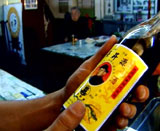 | |
Chang Sheng Yuan huang jiu has been in business since the Qing Dynasty, when it is claimed that The Empress Dowager Cixi herself came to this winery and was impressed by the wine's taste.
Gu: How long is the history of this shop?
Lao tou: more than 300 years
Gu : Which generation are you from?
Lao tou: I’m the sixth generation
Gu: Your family has been making wine this whole time?
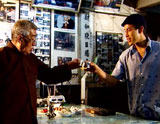 | |
Lao tou: yes the tradition has been passed down through my family, Our huang jiu is a “yin yang” wine, It increases blood circulation and is good for your stomach, It’s a healthy alcohol.
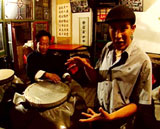 | |
This is called a "jiu gang" and it holds 700 bottles of "Huang Jiu" in this big bottle. It's really got a bite to that smell. You can drink it cold.
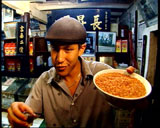 | |
So this is the product, and this is the raw material. This is the "Luo Mi" which is a kind of rice, and his is the huang jiu, or Yellow wine, Its a kind of rice wine, and this looks kinda good, but, I'd rather drink the wine.
 | |
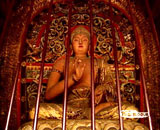 | |
Southwest of Ping Yao lies a Buddhist temple, The Shuang Lin Si, that houses more than 2,000 painted clay statues from the Yuan through the Ming Dynasty. These sculptures are exquisitely rendered and life like, earning the temple its nickname "the Treasure House of Painted Sculptures. "These sculptures were molded onto wooden skeletons, like flesh to bone, and even in a deteriorated form, appear life like. Wei Tuo, a guardian spirit of guan yin, is considered one of the best piecies in the entire temple.
 | |
If you look at this grand old severed tree right here, you get an idea of how old this temple actually is. When I look at this tree I'm reminded of the statues housed within these temple walls. You can look at the tree and notice its beauty, however it's kept alive and standing by this simple wooden column right here. It’s sad to think that the preservation of the statues here isn't as easy as a simple wooden column.
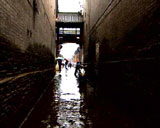 | |
 | |
As the much-needed rain begins to fall on Ping Yao, I hope that it will cleanse the city, and wash away the gathering dust brought by the ages. The raindrops slip down sloping roofs, and accumulate into small puddles on the brick paved streets, quenching the city's thirst, and revealing a melancholy beauty.
 | |
The days in Ping Yao pass by fast and it feels more like a trip in a time machine than anything else. As the rain clears and the sun peeks through the clouds, I say good-bye to the ancient streets of Ping Yao, and prepare to head back to the concrete jungle called home.
Like waking up from a pleasant dream, all good dreams must come to and end. Thanks for watching Travelogue, I'm Gu Ming, I'll see ya next time!
Editor:Chen Minji

